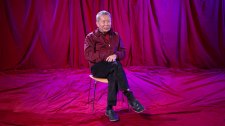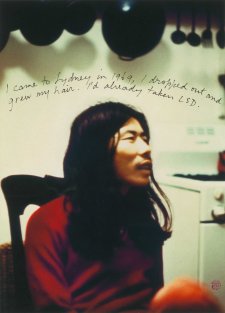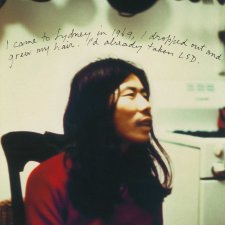- About us
- Support the Gallery
- Venue hire
- Publications
- Research library
- Organisation chart
- Employment
- Contact us
- Make a booking
- Onsite programs
- Online programs
- School visit information
- Learning resources
- Little Darlings
- Professional learning
Photographer, performer and storyteller William Yang is known for an
intensely sustained body of work that examines issues of cultural and
sexual identity. His work unflinchingly documents the lives of his
friends and community and his own lived experience with curiosity,
sensitivity and humour. Born in Mareeba, near Cairns, Yang grew up in a
family who repudiated their Chinese heritage to escape the intolerance
characteristic of mid-20th century Australia. He realised he was Chinese
at age six, after being subjected to a bigoted taunt at school. Self portrait #2
reworks a photograph of Yang as a child with handwritten text
describing the experiences of racism, othering and his identity as a
Chinese-Australian. Through the overlay of personal text, the work
becomes an intimate diary entry shared with the viewer, offering a sense
of closeness and connection.
Purchased 2022
© William Yang
Self portrait #2, by William Yang and an unknown photographer from circa 1949 and 2007.
This black and white photographic portrait is an inkjet print on paper. It measures 108.5 cm high and 72.5 cm wide, with a 10 cm thick white picture mat and a thin pale wooden frame.
A young black-haired boy stands posing, facing the camera open-mouthed with teeth exposed at the point of offering a smile. His whole body is in the frame, one arm up on his hip, the other resting on the handlebars of a small children’s metal bike.
There is little fine detail in the photograph due to its graininess and its age. He stands on dark floorboards in front of some textured draped curtains.
The boy wears a white high-collared short-sleeved shirt with a knotted tie that has a blurred indecipherable symbol on its tip. His shirt tucks into white shorts which is held in place by a white belt. His knees are bare. He wears white socks and black gym shoes.
Filling the surface of the boy’s shirt and shorts is a handwritten passage in black ink. It begins at the collar, words curving to the collar’s rounded shape. As each written line progresses, it widens out, following this same curve. The lines of text straighten out by the time the words travel over the boy’s shorts.
The text passage is broken up by the blurred symbol on the boy’s tie and lower down, words curve in and around where his small hand grasps the bike’s handlebars, near his hip.
In neat cursive hand the text reads: ‘When I was about six years old one of the kids at school called me "Ching Chong China man, born in a jar, Christened in a teapot, Ha Ha Ha. I had no idea what he was talking about but I knew from his expression that he was being horrible to me, so I went home to my mother and I said to her, "Mum I’m not Chinese, am I?" My mother said to me very sternly, "Yes you are." Her tone was hard and it shocked me. I knew in this moment being Chinese was like a terrible curse and I could not rely on my mother for help. Or my brother who was four years older than me, very much more experienced in the world. He chimed in, "And you better get used to it."
The words come to an end 2 inches before the hem of his shorts.
At the cuff of the boy’s right short pant is a small purple ink stamp with neatly rendered Chinese characters inside a thin purple square. On the cuff of the boy’s left short pant is written "Self Portrait #2" and in smaller handwriting, ‘Photographer Unknown. William Yang. 1947.’, and in even smaller print underneath, ‘2007, 5/30’.
Audio description written and voiced by Kate Matthews
William Yang (age 4 in 1947)



On one level The Companion talks about the most famous and frontline Australians, but on another it tells us about ourselves.



William Yang on his heritage and becoming a photographer in the 70s.



William Yang shares the stories behind his autobiographical self portraits that celebrate his cultural heritage and identity.